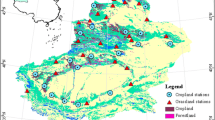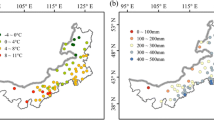Abstract
Vegetation indices (VIs) from satellite remote sensing have been extensively applied to analyze the trends of vegetation phenology. In this paper, the NDVI (normalized difference vegetation index) and SR (simple ration), which are calculated from the same spectral bands of MODIS data with different mathematical expressions, were used to extract the start date (SOS) and end date (EOS) of the growing season in northern China and Mongolia from 2000 to 2015. The results show that different vegetation indices would lead to differences in vegetation phenology especially in their trends. The mean SOS from NDVI is 15.5 d earlier than that from SR, and the mean EOS from NDVI is 13.4 d later than that from SR. It should be noted that 16.3% of SOS and 17.2% of EOS derived from NDVI and SR exhibit opposite trends. The phenology dates and trends from NDVI are also inconsistent with those of SR among various vegetation types. These differences based on different mathematical expressions in NDVI and SR result from different resistances to noise and sensitivities to spectral signal at different stage of growing season. NDVI is prone to be effected more by low noise and is less sensitive to dense vegetation. While SR is affected more by high noise and is less sensitive to sparse vegetation. Therefore, vegetation indices are one of the uncertainty sources of remote sensing-based phenology, and appropriate indices should be used to detect vegetation phenology for different growth stages and estimate phenology trends.
Similar content being viewed by others
References
Atzberger C, Klisch A, Mattiuzzi M et al., 2014. Phenological Metrics Derived over the European Continent from NDVI3g Data and MODIS Time Series. Remote Sensing, 6(1): 257–284. doi: 10.3390/rs6010257
Balzarolo M, Vicca S, Nguy-Robertson A L et al., 2016. Matching the phenology of Net Ecosystem Exchange and vegetation indices estimated with MODIS and FLUXNET in-situ observations. Remote Sensing of Environment, 174: 290–300. doi: 10.1016/j.rse.2015.12.017
Beck P S A, Atzberger C, Høgda K A et al., 2006. Improved monitoring of vegetation dynamics at very high latitudes: a new method using MODIS NDVI. Remote Sensing of Environment, 100(3): 321–334. doi: 10.1016/j.rse.2005.10.021
Bradley B A, Jacob R W, Hermance J F et al., 2007. A curve fitting procedure to derive inter-annual phenologies from time series of noisy satellite NDVI data. Remote Sensing of Environment, 106(2): 137–145. doi: 10.1016/j.rse.2006.08.002
Buitenwerf R, Rose L, Higgins S I, 2015. Three decades of multi-dimensional change in global leaf phenology. Nature Climate Change, 5(4): 364–368. doi: 10.1038/nclimate2533
Chen J M, Pavlic G, Brown L et al., 2002. Derivation and validation of Canada-wide coarse-resolution leaf area index maps using high-resolution satellite imagery and ground measurements. Remote Sensing of Environment, 80(1): 165–184. doi: 10.1016/S0034-4257(01)00300-5
Chuine I, Morin X, Bugmann H, 2010. Warming, Photoperiods, and Tree Phenology. Science, 329(5989): 277–278. doi:10.1126/science.329.5989.277-e
Cong N, Wang T, Nan H J et al., 2013. Changes in satellite- derived spring vegetation green-up date and its linkage to climate in China from 1982 to 2010: a multimethod analysis. Global Change Biology, 19(3): 881–891. doi: 10.1111/gcb. 12077
de Beurs K M, Henebry G M, 2005. Land surface phenology and temperature variation in the International Geosphere- Biosphere Program high-latitude transects. Global Change Biology, 11(5): 779–790. doi: 10.1111/j.1365-2486.2005. 00949.x
Delpierre N, Dufrêne E, Soudani K et al., 2009. Modelling interannual and spatial variability of leaf senescence for three deciduous tree species in France. Agricultural and Forest Meteorology, 149(6-7): 938–948. doi: 10.1016/j.agrformet.2008.11.014
Ding M J, Li L H, Zhang Y L et al., 2015. Start of vegetation growing season on the Tibetan Plateau inferred from multiple methods based on GIMMS and SPOT NDVI data. Journal of Geographical Sciences, 25(2): 131–148. doi: 10.1007/s11442-015-1158-y
D’Odorico P, Gonsamo A, Gough C M et al., 2015. The match and mismatch between photosynthesis and land surface phenology of deciduous forests. Agricultural and Forest Meteorology, 214–215: 25–38. doi: 10.1016/j.agrformet.2015.07. 005
Fu Y H, Zhao H F, Piao S L et al., 2015. Declining global warming effects on the phenology of spring leaf unfolding. Nature, 526(7571): 104–107. doi: 10.1038/nature15402
Garonna I, de Jong R, Schaepman M E, 2016. Variability and evolution of global land surface phenology over the past three decades (1982–2012). Global Change Biology, 22(4): 1456–1468. doi: 10.1111/gcb.13168.
Garrity S R, Bohrer G, Maurer K D et al., 2011. A comparison of multiple phenology data sources for estimating seasonal transitions in deciduous forest carbon exchange. Agricultural and Forest Meteorology, 151(12): 1741–1752. doi: 10.1016/j.agrformet.2011.07.008
Ge Q S, Wang H J, Rutishauser T et al., 2015. Phenological response to climate change in China: a meta-analysis. Global Change Biology, 21(1): 265–274. doi: 10.1111/gcb.12648
Guo L, An Ning, Kaicun W, 2016. Reconciling the discrepancy in ground- and satellite-observed trends in the spring phenology of winter wheat in China from 1993 to 2008. Journal of Geophysical Research: Atmospheres, 121: 1027–42. doi: 10.1002/ 2015JD023969
Helman D, 2018. Land surface phenology: what do we really ‘see’ from space? Science of the Total Environment, 618: 665–673. doi: 10.1016/j.scitotenv.2017.07.237
Hird J N, McDermid G J, 2009. Noise reduction of NDVI time series: an empirical comparison of selected techniques. Remote Sensing of Environment, 113(1): 248–258. doi: 10.1016/j.rse.2008.09.003
Huete A, Didan K, Miura T et al., 2002. Overview of the radiometric and biophysical performance of the MODIS vegetation indices. Remote Sensing of Environment, 83(1–2): 195–213. doi: 10.1016/S0034-4257(02)00096-2
Jeganathan C, Dash J, Atkinson P M, 2014. Remotely sensed trends in the phenology of northern high latitude terrestrial vegetation, controlling for land cover change and vegetation type. Remote Sensing of Environment, 143: 154–170. doi: 10.1016/j.rse.2013.11.020
Jeong S J, Ho C H, Gim H J et al., 2011. Phenology shifts at start vs. end of growing season in temperate vegetation over the Northern Hemisphere for the period 1982–2008. Global Change Biology, 17(7): 2385–2399. doi: 10.1111/j.1365-2486. 2011.02397.x
Jin H X, Eklundh L, 2014. A physically based vegetation index for improved monitoring of plant phenology. Remote Sensing of Environment, 152: 512–525. doi: 10.1016/j.rse.2014.07.010
Karkauskaite P, Tagesson T, Fensholt R, 2017. Evaluation of the Plant Phenology Index (PPI), NDVI and EVI for start-of-season trend analysis of the northern hemisphere boreal zone. Remote Sensing, 9(5): 485. doi: 10.3390/ rs9050485
Liang L, Schwartz M D, Fei S L, 2011. Validating satellite phenology through intensive ground observation and landscape scaling in a mixed seasonal forest. Remote Sensing of Environment, 115(1): 143–157. doi: 10.1016/j.rse.2010.08.013
Lieth H, Radford J S, 1971. Phenology, resource management, and synagraphic computer mapping. BioScience, 21(881): 62–70. doi: 10.2307/1295541
Liu R G, Liu Y, 2013. Generation of new cloud masks from MODIS land surface reflectance products. Remote Sensing of Environment, 133: 21–37. doi: 10.1016/j.rse.2013.01.019
Liu R G, Shang R, Liu Y et al., 2017. Global evaluation of gap-filling approaches for seasonal NDVI with considering vegetation growth trajectory, protection of key point, noise resistance and curve stability. Remote Sensing of Environment, 189: 164–179. doi: 10.1016/j.rse.2016.11.023
Menzel A, Sparks T H, Estrella N et al., 2006. European phenological response to climate change matches the warming pattern. Global Change Biology, 12(10): 1969–1976. doi: 10.1111/j.1365-2486.2006.01193.x.
Mutanga O, Skidmore A K, 2004. Narrow band vegetation indices overcome the saturation problem in biomass estimation. International Journal of Remote Sensing, 25(19): 3999–4014. doi: 10.1080/01431160310001654923
Nagai S, Nasahara K N, Muraoka H et al., 2010. Field experiments to test the use of the normalized-difference vegetation index for phenology detection. Agricultural and Forest Meteorology, 150(2): 152–160. doi: 10.1016/j.agrformet.2009.09. 010
Peng S S, Piao S L, Ciais P et al., 2013. Asymmetric effects of daytime and night-time warming on Northern Hemisphere vegetation. Nature, 501(7465): 88–92. doi: 10.1038/nature 1243
Peñuelas J, Filella I, 2001. Phenology; Responses to a warming world. Science, 294(5543): 793–795. doi: 10.1126/science. 1066860
Piao S L, Fang J Y, Zhou L M et al., 2006. Variations in satellite- derived phenology in China’s temperate vegetation. Global Change Biology, 12(4): 672–685. doi: 10.1111/j.1365- 2486. 2006.01123.x
Piao S L, Tan J G, Chen A P et al., 2015. Leaf onset in the northern hemisphere triggered by daytime temperature. Nature Communications, 6. 6911. doi: 10.1038/ncomms7911
Richardson A D, Black T A, Ciais P et al., 2010. Influence of spring and autumn phenological transitions on forest ecosystem productivity. Philosophical Transactions of the Royal Society B: Biological Sciences, 365(1555): 3227–3246. doi: 10.1098/rstb.2010.0102
Schwartz M D, Ahas R, Aasa A, 2006. Onset of spring starting earlier across the Northern Hemisphere. Global Change Biology, 12(2): 343–351. doi: 10.1111/j.1365-2486.2005.01097.x
Slayback D A, Pinzon J E, Los S O et al., 2003. Northern hemisphere photosynthetic trends 1982–99. Global Change Biology, 9(1): 1–15. doi: 10.1046/j.1365-2486.2003.00507.x
Steltzer H, Post E, 2009. Seasons and Life Cycles. Science, 324(5929): 886–887. doi: 10.1126/science.1171542
Studer S, Stockli R, Appenzeller C et al., 2007. A comparative study of satellite and ground-based phenology. International Journal of Biometeorology, 51(5): 405–414. doi: 10.1007/s00484-006-0080-5
Vermote E F, Kotchenova S, 2008. Atmospheric correction for the monitoring of land surfaces. Journal of Geophysical Research-Atmospheres, 113(D23): D23S90. doi: 10.1029/2007 JD009662
Viña A, Gitelson A A, Nguy-Robertson A L et al., 2011. Comparison of different vegetation indices for the remote assessment of green leaf area index of crops. Remote Sensing of Environment, 115(12): 3468–3478. doi: 10.1016/j.rse.2011. 08.010
White K, Pontius J, Schaberg P, 2014. Remote sensing of spring phenology in northeastern forests: a comparison of methods, field metrics and sources of uncertainty. Remote Sensing of Environment, 148: 97–107. doi: 10.1016/j.rse.2014.03.017
White M A, de Beurs K M, Didan K et al., 2009. Intercomparison, interpretation, and assessment of spring phenology in North America estimated from remote sensing for 1982–2006. Global Change Biology, 15(10): 2335–2359. doi: 10.1111/ j.1365-2486.2009.01910.x
Wu C Y, Gonsamo A, Gough C M et al., 2014. Modeling growing season phenology in North American forests using seasonal mean vegetation indices from MODIS. Remote Sensing of Environment, 147: 79–88. doi: 10.1016/j.rse.2014.03.001
Wu C Y, Hou X H, Peng D L et al., 2016. Land surface phenology of China’s temperate ecosystems over 1999–2013: Spatial- temporal patterns, interaction effects, covariation with climate and implications for productivity. Agricultural and Forest Meteorology, 216: 177–187. doi: 10.1016/j.agrformet. 2015.10.015
Yang Y T, Guan H D, Shen M G et al., 2015. Changes in autumn vegetation dormancy onset date and the climate controls across temperate ecosystems in China from 1982 to 2010. Global Chang Biology, 21(2): 652–665. doi: 10.1111/gcb. 12778
Zhang G L, Zhang Y J, Dong J W et al., 2013. Green-up dates in the Tibetan Plateau have continuously advanced from 1982 to 2011. Proceedings of the National Academy of Sciences of the United States of America, 110(11): 4309–4314. doi: 10.1073/ pnas.1210423110
Zhang X Y, Friedl M A, Schaaf C B et al., 2003. Monitoring vegetation phenology using MODIS. Remote Sensing of Environment, 84(3): 471–475. doi: 10.1016/S0034-4257(02) 00135-9
Zhang X Y, Friedl M A, Schaaf C B et al., 2004. Climate controls on vegetation phenological patterns in northern mid- and high latitudes inferred from MODIS data. Global Change Biology, 10(7): 1133–1145. doi: 10.1111/j.1529-8817.2003.00784.x
Zhang X Y, Friedl M A, Schaaf C B, 2006. Global vegetation phenology from Moderate Resolution Imaging Spectroradiometer (MODIS): evaluation of global patterns and comparison with in situ measurements. Journal of Geophysical Research- Biogeosciences, 111(G4): G04017. doi: 10.1029/2006 JG000217
Zhao Hu, Yang Zhengwei, Li Lin et al., 2011. Improvement and comparative analysis of indices of crop growth condition monitoring by remote sensing. Transactions of the Chinese Society of Agricultural Engineering, 2 (1): 243–249. (in Chinese)
Author information
Authors and Affiliations
Corresponding author
Additional information
Foundation item: Under the auspices of the Strategic Priority Research Program of the Chinese Academy Sciences (No. XDA19080303), the National Key Research and Development Program for Global Change and Adaptation (No. 2016YFA0600201), the Distinctive Institutes Development Program, Chinese Academy of Sciences (No. TSYJS04), the National Natural Sciences Foudation of China (No. 41171285)
Rights and permissions
About this article
Cite this article
Zuo, L., Liu, R., Liu, Y. et al. Effect of Mathematical Expression of Vegetation Indices on the Estimation of Phenology Trends from Satellite Data. Chin. Geogr. Sci. 29, 756–767 (2019). https://doi.org/10.1007/s11769-019-1070-y
Received:
Accepted:
Published:
Issue Date:
DOI: https://doi.org/10.1007/s11769-019-1070-y




